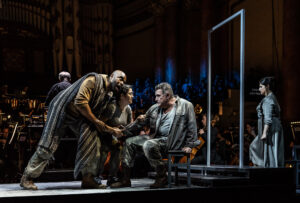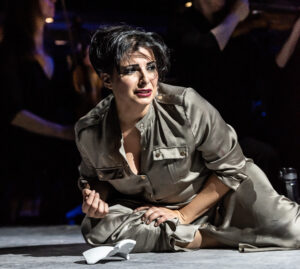Had Ismail Pasha managed his court more wisely, perhaps he would not have squandered the power of his country. The grandson of Muhammad Ali, the first khedive of Egypt, continued with panache the work begun by his grandfather: he built thousands of schools, created a dense network of telegraphic and railway connections, modernized the port of Alexandria, and saw to the development of the fine arts, theatre and opera. In 1879, before the sultan of the Ottoman Empire removed him from office on the initiative of the British government, he stated that ‘my country is no longer in Africa; we have become part of Europe.’ Twenty years later, the illustrated edition of the Orgelbrand Encyclopedia mercilessly summed up his extravagance and ambition as follows: ‘in order to salvage at least his own personal fortune, he stopped paying interest on his debts; however, under pressure from European powers acting in defense of his creditors, he yielded to their demands. […] His unsuccessful attempt to conquer Abyssinia (1876) also contributed to the destruction of the appeal that he had possessed once upon a time in Europe because of his supposed civilizational aims.’
We have, above all, advocates of post-colonial theory to thank for the stubborn myth that the operatic œuvre was a luxury good in Egypt, imported on credit with an eye to a small clientele basically not interested in it. In reality, opera began to enter cultural circulation there back at the end of the 18th century, via travelling troupes making the rounds between Naples, Alexandria and Cairo. The presentations, originally organized with an eye to the Europeans living in the overseas country, gained increasing interest among the local population. The Egyptians demanded the building of new theatres, formed their own ensembles, made adaptations in the spirit of the Arabic tradition. Former muezzin Salamah Hijazi shone in musical adaptations of plays by Shakespeare, Corneille and Racine; European operas were presented in both versions up until the 1920s.
Rafael Rojas (Radamès) and Alexandra Zabala (Aida). Photo: Clive Barda
So it is no wonder that Ismail Pasha decided to inaugurate the operations of the Royal Opera House in Cairo – founded in honour of the Suez Canal opening – with a new work by Verdi, or more precisely, a festive hymn for the occasion. The composer rejected the proposal of the khedive, who in light of this contented himself with a staging of Rigoletto. He had no intention, however, of giving up: shortly thereafter, he placed before Verdi the script of Aida, penned by famous French Egyptologist Auguste Mariette. This time, the bait caught. In November 1870, the score was basically ready, but the première was delayed on account of an unfortunate turn in the Franco-Prussian war – the costumes and scenery were stuck in besieged Paris. The first showing of Aida finally took place on Christmas Eve 1871 and was received enthusiastically by the audience – importantly, on the night of the première comprised above all of diplomats, dignitaries and critics, which had the effect of reinforcing the legend of opera’s elite character in Egypt.
Meanwhile, Aida almost immediately gained enormous popularity. Perhaps because, in comparison with Verdi’s earlier experiments, it is a work almost Classical in form, composed to a conventional and exceptionally clear libretto that revolves around the drama of duty – understandable to audiences on both sides of the Mediterranean. Aida’s greatest asset, however, is its music: an ideal marriage of the Italian tradition with French grand opéra, a captivating combination of opulent scenes of war and triumph with almost Impressionist sound painting in the more intimate moments of the narrative. Some complain that Aida lacks dramatic nerve: I adore swimming in the ‘heavenly’ long passages of this score, which is marked by the subtle lyricism of its cantilenas and the sensual softness of its quasi-Oriental orchestral textures.
For this reason, I set out without deliberation for another encounter with the musicians of Opera North, who last season – under the same baton of Sir Richard Armstrong – put on a show of the highest artistry in Strauss’ Salome. This time, my choice fell upon a semi-staged performance of Aida at Sage Gateshead, one of the most functional and acoustically best music centers in the world. The edifice designed by Norman Foster is a masterpiece of so-called organic architecture – it brings to mind a giant cocoon towering over the bank of the River Tyne. Inside it are three separate buildings divided by walls made of a soundproof concrete blend. The entire steel construction is hidden under an asymmetrical, aerodynamic copula made of glass. The main concert hall seating 1650 alludes loosely to the form and proportions of the Wiener Musikverein, to which fact it owes its phenomenal acoustics – warm and selective, despite a quite lengthy reverberation.
Eric Greene (Amonasro), Alexandra Zabala, Rafael Rojas and Alessandra Volpe (Amneris). Photo: Clive Barda
In such conditions and with such a superb ensemble, they successfully approximated the ideal. It had been a long time since I had heard an Aida led by such a sensitive hand, with such respect for the composer’s instructions, with such care taken to diversify the subtle instrumental shades, especially in the strings. The Opera North chorus displayed a similar sensitivity to intonation and to the timbre of each individual note and sonority. In Act I, I was slightly disappointed with Rafael Rojas, an otherwise experienced and very technically proficient tenor. Fortunately, he quickly pulled himself together and erased my so-so impression of Radamès’ romance ‘Celeste Aida’ devoid of brilliance and passion. His beloved found an ideal performer in the person of Alexandra Zabala – a singer blessed with a supremely lyrical and, at the same time, resonant soprano, perfectly balanced throughout the range of Aida’s part. Her sweet, tender pianissimo high C from the aria ‘O patria mia’ will remain in my memory for a long time. A splendid counterweight for the delicate Aida lost in a cruel world was created by Alessandra Volpe in the role of Amneris. Her dense, sensual voice, beautifully open at the top, is placed somewhere between a mezzo-soprano and a dramatic soprano – this singer, who will be performing next season as, among others, Santuzza in Bari and Carmen in Oslo, is worthy of further attention. A highly suggestive Ramfis was created by Petri Lindroos, an ominous, ice-cold bass (superb Judgement scene in Act IV). It was an excellent idea to cast Eric Greene in the role of Amonasro – the American singer has at his disposal a deep, dark-timbred baritone that he wields with uncommon musicality and feel for style.
The semi-staging, prepared by Annabel Arden (director), Joanna Parker (designer and video director), Dick Straker (video designer) and Richard Moore (lighting designer), though quite naturally minimalist, was even so striking at times with its excess of details distracting attention from the musical narrative. The production team decided to transport Aida into the realities of a contemporary conflict, supplementing the acting tasks with projections displayed at the back of the stage that alluded unambiguously to the current war in Syria. A pity, for the singers placed in front of the orchestra were moving in a metaphorical space, very intelligently arranged using a few multi-functional props (a doorframe with no door, designating the fluid border between the worlds of the Egyptians and the ‘foreigners’; a table which, in the final act, becomes the tomb of Aida and Radamès). The singers’ superb acting and excellently-prepared stage movement permitted one to turn a blind eye to the lack of originality in the costumes, which in ‘new’ opera theatre more and more often take the form of universal signs and symbols (if a ruler, then in a suit; if a fighter, then in a field uniform; if a high-born woman, then in high heels and peignoir). Despite this, I have the impression that staged concert performances should be more ‘static’, or at any rate based on different means of expression than in the case of a fully-staged rendition. Especially if my gloomy prediction that semi-staged productions will become the daily bread of opera comes to pass.
Alessandra Volpe. Photo: Clive Barda
However, experiencing Aida in a perspective so intimate, devoid of all extravagance, did make me aware of something about which I had never thought before. With whom did the first Egyptian viewers of Verdi’s opera identify? With the victorious army of the Pharaohs, or with the conquered Ethiopians? This a dilemma for post-colonial theorists, considerably more intriguing than lengthy discussion of whether Aida was an imperial spectacle for alienated strangers from Europe in Cairo, or yet another masterpiece of a form for which the Egyptians had acquired a taste back during the reign of the Mamluks.
Translated by: Karol Thornton-Remiszewski



